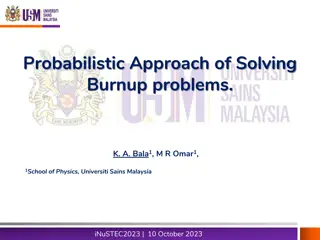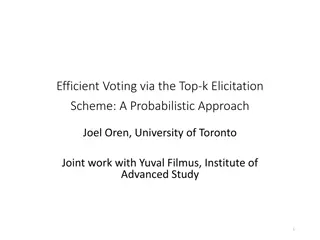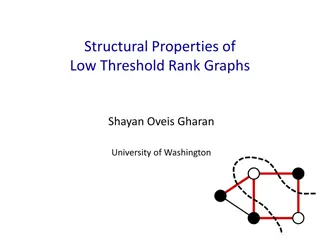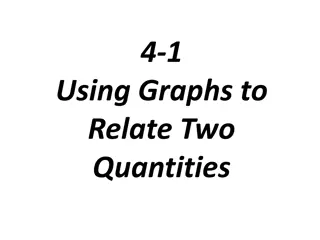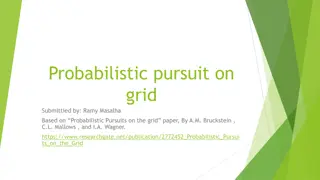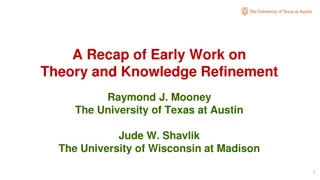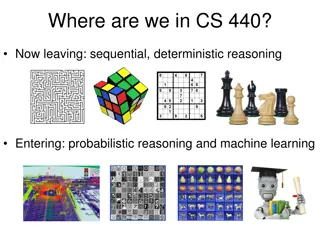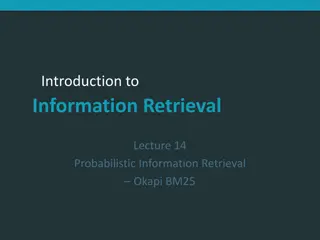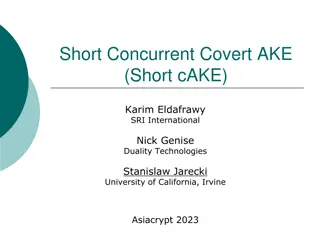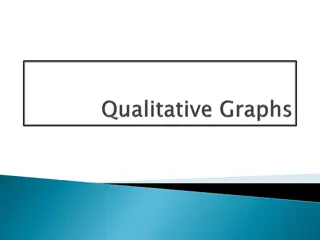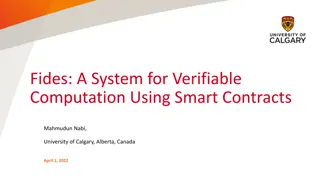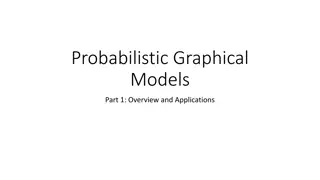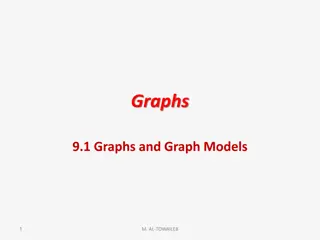Efficient Probabilistic K-core Computation on Uncertain Graphs
This paper presents an efficient method for computing probabilistic k-core on uncertain graphs. It discusses the challenges in dealing with uncertainties in real-life networks and proposes a model to extend k-core to uncertain graphs. Through experimental validation, the paper concludes on the effectiveness of the proposed approach.
Download Presentation

Please find below an Image/Link to download the presentation.
The content on the website is provided AS IS for your information and personal use only. It may not be sold, licensed, or shared on other websites without obtaining consent from the author.If you encounter any issues during the download, it is possible that the publisher has removed the file from their server.
You are allowed to download the files provided on this website for personal or commercial use, subject to the condition that they are used lawfully. All files are the property of their respective owners.
The content on the website is provided AS IS for your information and personal use only. It may not be sold, licensed, or shared on other websites without obtaining consent from the author.
E N D
Presentation Transcript
Efficient Probabilistic K-core Computation on Uncertain Graphs You Peng, Ying Zhang, Wenjie Zhang, Xuemin Lin, Lu Qin University of New South Wales, University of Technology Sydney
Outline Introduction Problem Definition Proposed method Experiment Conclusion 2
K-Core G(V,E): undirected graph K-core: maximal subgraphs where every node s degree in this subgraph k 2-core 3
Uncertain Graphs Many real life networks are associated with uncertainty: Data collection process Privacy-preserving reasons Natural applications o Biological networks, protein-interaction networks o Social networks 4
Probabilistic k-core Probabilistic k-core : Dealing with edges with probabilities Various versions for extending k-core to uncertain graphs Expected k-core model ?,? -core KDD 2014 ?,? -core this paper 5
Probabilistic k-core ?,? -core KDD 2014 Maximal subgraph K(?,?)-core: P(degree k) ? Kk-core: degree k Probabilities distribution 0.35 0.3 0.25 Probability 0.2 0.15 ?(?????? ?) 0.1 0.05 0 1 2 3 4 5 6 degree 6
Probabilistic k-core Expected k-core model Maximal subgraph Sum all neighbor edges probability ? Kexpected k-core: ?=1 Kk-core: degree k ?(??) ? 7
Before introduce our model, we will introduce possible world semantics 8
Possible World Semantics ?(?1): ? ?,? ? ?,? 1 ? ?,? ?(?2): ? ?,? (1 ? ?,? ) ?(?,?) = 0.05 23= 8 possible worlds in total = 0.05 Two example possible worlds 9
Probabilistic k-core ?,? -core this paper P(u): probability u in k-core P(a) = P(?1)+ P(?2)+ ? P(u): ?=1 K???: P(degree k) ? ?(??) ? ?? ?? ? ???? 10
Probabilistic k-core ?,? -core this paper K-core memberships (?,?)-core: all u, ? ? ? ? P(u): ?=1 K???: P(degree k) ? ?(??) ? ?? ?? ? ???? 11
Applications Vital vertices set detection Influential social communities detection Social network engagement 12
Challenges How to compute P(u)? Enumerate possible worlds? 2? possible worlds in total NP-hardness (?,?)-core: all u, ? ? ? ? P(u): ?=1 ?(??) ? ?? ?? ? ???? 13
0.6 A B A B toss Instance graph 1 (A not in 2-core) 0.5 0.4 C C A B Instance graph s (A in 2-core) ? ? =# ?? ???????? ??????:? ?? ? ???? # ?? ??? ???????? ?????? C 15
s = # of all instance graphs ? ? =# ?? ???????? ???? ?:? ?? ? ???? ?? ? ????????????? ?? ?(?) ? ?????(?? ? ? ? ? ? ? ??? ?????????? 1 ? ? ?) 16
Observation 1Deterministic k-core pruning Prune D E D E 0.6 0.6 0.6 A B 0.5 0.4 C K=2 17
Observation 2upper bound # ?? ???????? ???? ? ? ? ???? ???? 2 A in 2,? -core # ?? ???????? ???? ? ? ?? 2 ???? ? ? ?:dynamic programming ? deg ? Initial upper bound 0.6 A B A B toss Instance graph 1 (A not in 2-core) 0.5 0.4 C C A B At least 2 neighbors Instance graph s (A in 2-core) C 18
Observation 2 : tighter upper bound Get tighter bound? Markov Inequality min(?(? ?,??,?+(??)) ? ? ? ?=1 Example 19
Observation 2 : tighter upper bound Example: b c d 1.0 0.25 0.5 20
Observation 2 : tighter upper bound Example: min ? ?,? ,?+? +min ? ?,? ,?+? =min 1,0.25 +min 1,0.5 ? ? = 0.375 2 2 21
Observation 3 : early terminate in one instance Toss 1 miss: no need to toss 2 and 3 toss 1 0.6 A B toss1 A B 0.5 0.4 0.5 toss 3 0.4 toss 2 C toss 3 toss 2 C 23
Observation 3 : early terminate in one instance Sampling based upper/lower bounds for pruning Three status : confirmed in k-core of ?? X: excluded from k-core of ?? ?: needing further computation K=2 24
Observation 4: early terminate in all samples A B ?1(A not in 2-core) #?? ???????? ???? ? ? ?? 2 ???? ? ? ?? ?????? Gk ?? ???? ?????? ???+1 ?? ? C A B ??(A in 2-core) 0.6 A B toss C 0.5 0.4 C A B ??(A in 2-core) C 25
Observation 4: early terminate in all samples ?1: current # of instance graphs u in k-core ?2: # of not sampled instance graphs Lower bound: ? ? =?1 ? Upper bound: ?+? =n1+?2 ? Exclude u : ?+? < ? Include u : ? ? ? 26
Challenge Only one node not sure in one instance graph-> sample all edges Only node not sure in whole sampling -> sample all instance graphs How? K-core membership check Two search paradigms nodes not sure 27
Advanced sampling algorithms K-core membership check: Active update: choose an edge and sample it Passive update: sample an edge lead to update of neighbors upper and lower bound. 28
Summary Monte Carlo sampling : approximate result with theoretical guarantee. Basic sampling algorithm Pruning techniques o Deterministic K-core based pruning o Probabilistic Upper bound based pruning o Sampling based upper/lower bounds for pruning Advanced sampling algorithm K-core membership check o Active update o Passive update 29
Experiments Datasets Flickr: edge probability - Jaccard coefficient on interest groups DBLP: edge probability - an exponential function on the number of collaborations. Email Eron and Yelp: edge probability - random from interval[0,1]. Default k is 15 and ? is 0.7. 30
Experiments Advanced sampling about one order faster than baseline when vary k Bsample: Basic sampling Asampe: Advanced sampling 31
Experiments Advanced sampling several times faster than baseline when varying ? Bsample: Basic sampling Asampe: Advanced sampling 32
Experiments Pruning techniques influence BSample : Baseline BSample+P: Add deterministic k-core pruning to baseline BSample+PU: Add upper and lower bounds to Bsample+P Asample: Add k-core membership check to Bsample+PU Advanced technique improves most 33
Experiments Pruning techniques influence BSample : Baseline BSample+P: Add deterministic k-core pruning to baseline BSample+PU: Add upper and lower bounds to Bsample+P P and U reduce similar candidates size 34
Experiments 200 samples is enough Jaccard distance 200 and 4000 is only 0.02 Running time acceptable in practice 35
Experiments Engagement: Brightkite. (|V|=58,228, |E|=214,078) Influence spread: Twitter graph.(|V|=81,306, |E|=1,768,149) 36
Conclusion A new k-core model, ?,? -core model, based on possible world semantics A new perspective both in semantic analysis and empirical study Propose efficient pruning rules, upper and lower bounds and k-core membership check Proposed techniques significantly improves efficiency and effectiveness 37
Questions 38




